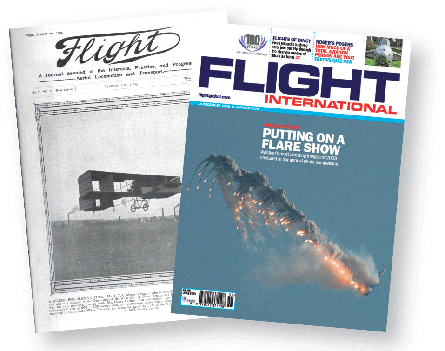It is an immensely humbling experience to be editing a magazine that has been appearing continuously since a few weeks after Samuel Cody's first airborne hop at Farnborough, through two world wars and a Cold War, and into today's "fast-food" era of instant information gratification via the web.
Flight International today may look very different to the black and white journal that grainily charted the early exploits of those magnificent men in their flying machines. But the heart and soul of the magazine has not changed much. We still aim to report and make sense of all that is important in what is now a global multi-billion dollar industry. And we get as enthusiastic about new technology in action as did our predecessors at the sight of a fragile-looking biplane spluttering its way over hedgerows.
 |
|---|
The Story so far - our first and most recent editions |
One of the strengths of Flight International is that our writers are passionate about the industry that they write about. It is why many of them stay for decades and why the magazine has had only a handful of editors in 100 years.
It's an easy industry to love, combining innovative engineering, global political intrigue, the grace and beauty of aircraft, the challenge of airmanship, business risk-taking and today's equivalent of pioneers such as the Wrights and Cody - driven, somewhat eccentric individuals who want to fulfil dreams...the Richard Bransons, Steven Udvar-Hazys, Michael O'Learys, Vern Raburns and Ed Swearingens.
It's a cliche, but tapping out that first draft of history and helping to create a 100-year archive of aviation's finest moments is something that makes working on Flight International a privilege. Over the past eight years, I've felt like my colleagues and I have had a front row seat to watch the most amazing movie ever, even helping in a small way to write the script.
 |
|---|
|
It is not easy to summarise a century of aviation and choose the highlights of 5,000 issues of the world's oldest aerospace journal in 50-odd pages. So we have not tried to produce an encyclopaedia or a historical document, but something that gives a flavour of the magazine's evolution. We also look ahead to the next 100 years, with the chief executives of several of our advertising partners giving their views of the future and the challenges the industry faces.
For the front cover and main archive piece, we could have chosen from hundreds of iconic aircraft from the Wright Flyer to the Douglas DC-3, Concorde to the Boeing 747. But we have opted for the de Havilland Comet. It was not the most commercially successful airliner or the best-looking. As a piece of groundbreaking technology, it has plenty of rivals. However, it represented a seminal shift in aviation, from the pre-war generation of genuine "air-liners", flying cruise ships for the privileged few with time and money to spare, to an era of mass-market jet air travel. It also appeared roughly half way through our century, at the onset of the Cold War and a new age of prosperity, ushering in two decades of furious technological progress that gave birth to supersonic fighters, production helicopters, Concorde, the Jumbo Jet, space satellites and the Moon landing.
Whether you are new to the magazine or a Flight International veteran (perhaps even a Total Aviation Person to use Roger Bacon's ultimate accolade), welcome to our special centenary issue. We will be back next week with our first proper edition of 2009. In the meantime, we hope that you enjoy this one-off delve into history and that you will stay with us as we journey into our second exciting century.
Source: Flight International

















